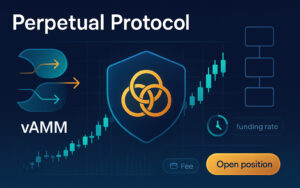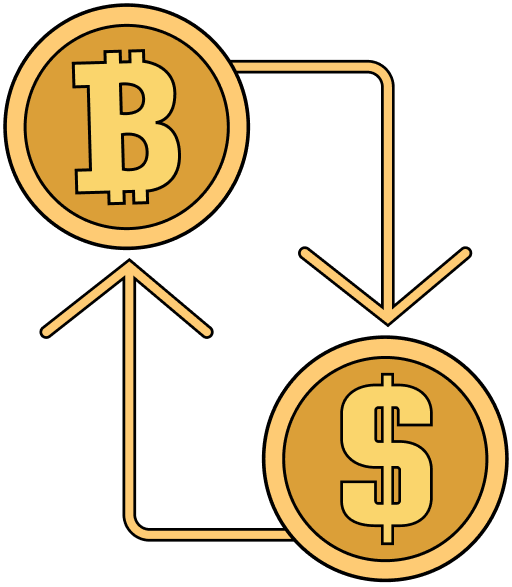Introduction
Perpetual Protocol is an on-chain decentralised finance (DeFi) protocol that enables users to trade perpetual futures. The protocol provides continuous leveraged trading without expiration via automated market making as opposed to the standard order book. Its mission is making perpetuals accessible for every person with a web3 wallet while keeping it permissionless and transparent for trading.

vAMM, perpetual chart and smart-contract flow
Perpetual Protocol adalah apa?
Perpetual Protocol offers perpetual futures contracts that are priced according to the value of an underlying asset — for instance, a cryptocurrency. You can long or short with leverage, which means profits and losses are amplified. Unlike spot trading, perpetuals enable you to bet on price action or hedge existing exposure without actually holding the underlying token.
It is organized so that it will run fully on public blockchains, so trade execution, margin balances, and positions show on-chain. That makes it easy for auditors, researchers, and users to verify how the system works. Because everything runs in smart contracts, there isn’t even a central counterparty managing trades.
Perpetual Protocol also focuses on reducing use cases. You will not have to register an account or face a KYC test for trading. You just connect your wallet, deposit collateral, and start positions. This development follows DeFi principles of self-custody and permissionless access.
Key technology — vAMM explained
One of the core ideas of the Perpetual Protocol is the virtual automated market maker, or vAMM. Whereas a standard AMM holds the actual token balances, the vAMM pretends to have liquidity with assistance from a formula. That allows the protocol to offer leveraged trading without locking up colossal amounts of every traded asset in the pool.
The vAMM has a price curve with virtual reserves. When the trader opens or closes the position, the contract adjusts virtual reserve values of new synthetic supply and demand. The overall outcome is an uninterrupted price function that shifts with trade size and direction. This model simplifies liquidity provision and avoids rebalancing of real-world tokens endlessly.
Since the vAMM operates with virtual reserves, there are required outside mechanisms for maintaining the on-chain price near the overall market. Price feeds and funding payments that transfer funds between longs and shorts are utilized by Perpetual Protocol for that purpose. Those instruments serve for anchoring the price of vAMM on an off-chain reference and for long-term correction of drift.
Trading features and mechanisms
Traders access the protocol through deposit of collateral and selection of leverage. Size of collateral determines how large of a position you can open as well as how close/far from liquidation you will be if the market moves against your position. Leverage increases profits and losses proportionally, so risk control counts.
Funding rates are recurrent settlement between long and short positions that aim at pulling on-chain perpetual price nearer outside spot prices. Longs compensate shorts if the perpetual price stands higher and shorts compensate longs if lower. Funding creates an economic incentive for the prices to converge without any change of open interest.
Liquidation rules protect the protocol and liquidity providers. When a trader’s margin falls below a safety level, the position falls at risk of partial or full liquidation. Liquidation occurs by covering the deficit with the currently available collateral of the trader and, if required, insurance funds or protocol mechanisms for loss covering and preventing the system from becoming insolvent.
Token and governance
It often has a governance token granting vote power on protocol decisions for token holders. Token holders vote on matters such as fees, new markets, risk parameters, and upgrades. Decentralizing authority, governance aims to allow the community to control the project’s direction.
Apart from governance, tokens can also serve economic functions such as staking, incentives for liquidity, or for rewards. These are utilized for bootstrapping the protocol by rewarding users that are providing collateral or risk-bearing capability. Reward mechanisms are flexible and are generally recommended and implemented through governance.
Security decisions are also encompassed by governance. Proposals can vote for funding of audits, bounty programs, and insurance-like reserves. This community governance forms part of the ways DeFi projects try long-term safety with leaving decision control open for token holders.
Security and risk considerations
As for a smart contract protocol, there are risks of DeFi for Perpetual Protocol. There are risks of loss from bugs in smart contracts, failure of oracles, and extreme price swings. For this reason, many projects publish their audits, carry out bug bounties, and keep insurance funds.
One area of weakness are the oracles. There are needed trusted price feeds for funding and liquidation for the system to stay balanced. When there are faulty prices from an oracle, it causes incorrect liquidation or facilitates arbitrage harming the protocol. That is why the protocol will typically use many trustworthy oracles or aggregated feeds.
User risks are leverage and margin calls. High leverage will erase a trader’s collateral very rapidly if markets are very volatile. All users of perpetuals should know their margin requirements, keep an eye on their positions, and have limits or stop orders set wherever possible. The design of the protocol and its documents usually detail how liquidations and safety features function.
Adoption and ecosystem
Perpetual Protocol sits on top of a wider DeFi system that includes wallets, analysis products, and cross-chain bridges. Traders access the protocol through a web application that connects with mainstream wallets such as Metamask and other EVM-compatible wallets. External products include charts, on-chain analysis, and trade monitoring which allow the user to make informed choices.
It can also be deployed or integrated on numerous chains and layer-2 networks for reduced gas costs and higher trading velocity. Integrations can also include order-routing aggregators, or on-chain perpetual position-tracking index providers. A healthy ecosystem gets attracted by traders and liquidity providers.
Community action also enters the equation. Forums, social outlets, and developer contributions help surface ideas for new markets and upgrades. Active communities also help with security by highlighting bugs and requesting risk parameter changes through governance.
How to use Perpetual Protocol — A Beginner’s Guide
Start with getting your web3 wallet connected and observe on which chains or networks the protocol supports. You will need a stable collateral token that will be maintained on the platform, so have that token available on your wallet. Read the platform’s documentation and understand the margin, leverage, and fees before adding funds.
Then, deposit collateral into the trading agreement and select the market and level of leverage for the desired position. Consider reviewing the estimated price of liquidation and required margin. Small test trades with low leverage are best for learning the interface without committing much capital.
Monitor positions, funding levels, and overall market conditions. You can also close a position if needed from the same screen. Pay particular attention to fees and funding payouts as they affect profitability and take them into account when making your decisions. Utilize risk controls like reducing leverage or partial closes when markets are becoming turbulent.
Conclusion
Perpetual Protocol facilitates permissionless trading of perpetual futures using smart contracts and virtual market making. The system combines on-chain clarity, price oracles, and funding processes to allow for ongoing leverage trading with no order book. While the model opens up new possibilities for permissionless derivatives, it also raises technical and monetary risks which users must understand. For entrants of such trading, learning how margin, leverage, funding, and liquidation function is essential. Read the documentation of the protocol together with community materials, start at low scales, and regard leveraged trading as a tool requiring extreme control.














 Twitter
Twitter
 Telegram
Telegram
